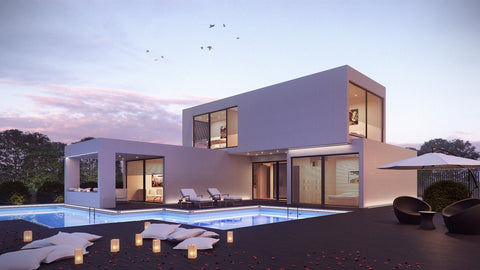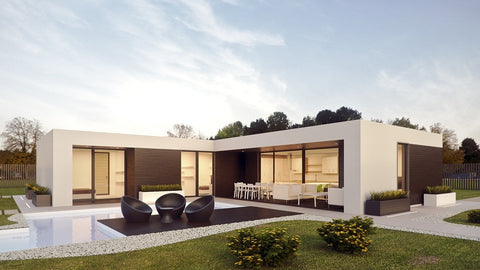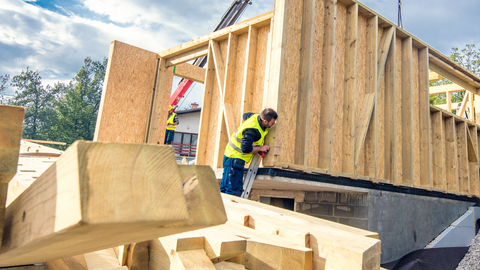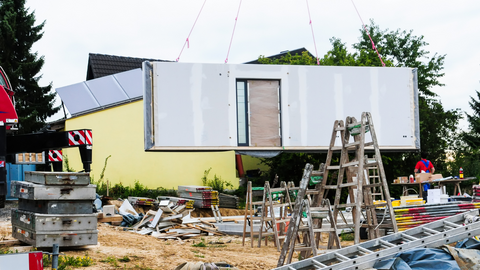September 09, 2022
The cost of building a home has steadily increased over the last few years.
In most modern industries automation has played a big part in reducing the total number of working hours with the intent of keeping a lid on prices, but the housing industry is intrinsically labour-intensive, and on a building site the use of automation has to this point been limited.
To maintain some level of affordability the building industry has begun exploring new ways of constructing homes that are more efficient and ultimately more cost-effective.
Although not an entirely new concept, the off-site prefabrication of homes is one of the more promising developments.
Prefabricating homes in a factory-type environment has the potential to improve construction time and quality control, reduce the impact of environmental factors and control costs.

Choosing to prefabricate your new home will have a number of advantages and disadvantages and it's worth considering them before making a decision. I've outlined the main ones here…
In simplest terms, a prefab home is a house that was built in sections inside of a special home-building facility. The sections then get moved to a home site, where they're assembled and prepared for the homeowner to move in.
As you might expect, this type of home is extremely easy to make and move in comparison to a traditional home.
Prefab homes are built in a unique way but, like traditional homes, they must meet basic requirements put in place by the relevant Government Departments. These requirements cover things like strength, durability, energy efficiency, and fire resistance.
Prefab homes come in three main iterations:
Manufactured homes:
A home in this category is built in sections and pieced together by professionals and heavy machinery at its final site.
Kit homes:
These homes are much simpler than manufactured homes, though they follow a similar build to the piecing style. In fact, most homebuyers can build a kit home themselves.
Modular homes:
These homes feature much more personalization, companies will often let you customize the floor plan of your purchase. However, unlike manufactured and kit homes, modular homes have an immovable foundation.
One of the benefits of prefab homes is that they tend to be highly energy efficient.
Prefab homes can save you money during the years you live in these homes because their designs generally have energy efficiency in mind.
In many ways, prefab homes are better for the environment than traditional homes, too. These homes are airtight and designed to minimize energy loss as much as possible.
Their tight seams and state-of-the-art windows keep heat in and reduce your energy bills in the process.
Because a prefab house's individual parts adhere to strict design guidelines, the seams in these homes are usually airtight. This standardized air-tightness helps to avoid leaks and airflows that can increase the energy and economic cost of heating and cooling your home.
As more and more consumers begin to search for ecological and sustainable home features, prefab home architects and contractors are designing several home models that incorporate everything from solar panels to wind turbines to rainwater catchment systems.
As a bonus, modular homes' tight construction has earned them a reputation for being able to withstand natural disasters.
Prefabricated (aka modular) homes go into a foundation like any other home. They can be high-quality, modern and elegant houses perfect for those who want a lower carbon footprint than the typical suburban home has.
Fast construction is one of the big advantages of prefab homes.
If you've ever built a house before (or know someone who has), you know that it's almost impossible to get the thing built on schedule.
Even if no major emergencies happen, things like the weather or slowed-down deliveries can drag out your building time and make it harder for you to move in when you want to.
Because the parts of a prefab home come pre-made, all you have to do is assemble them and hook up the home to the needed utilities. Hence the name “modular.”
The prefab goes up much faster because it arrives partially constructed.
The actual time needed to attach the parts on-site is considerably shorter than the time required to build a regular stick-built home. If you have a tight timeline and want to get into your new home on time, prefab homes are usually the quickest type of new home construction available to homeowners.
That means fewer days with labourers on site and less vulnerability to weather delays and illnesses that can extend the construction process by days and weeks.
Still, there's more to consider than just the construction time. Site preparation, including obtaining permits, can be a lengthy process.

Many people are turning to the prefab home trend these days because it provides them with an opportunity to save money while still becoming homeowners.
In general, prefab homes are much more affordable than traditional houses.
Building a prefab home is generally less expensive than building a comparable stick-built home. They use fewer materials, and the process of determining how much is needed is much more precise, so you don't have to worry about paying for materials that don't end up getting used.
Part of the savings has to do with labour. And on-site construction generally wastes much more materials that go into the building of the house.
It takes fewer labourers working over the course of fewer days to make a prefab move-in ready.
That saves you money. Plus, as we've mentioned, heating and cooling tend to be more affordable with prefab homes than with stick-built homes.
Compare the costs of what's available on the market with the cost of building a prefab. And remember that various levels of fittings and customization can raise or lower the cost of your prefab.
Prefab homes have the potential to be healthier than traditional homes.
When you're building a house on a building site, it's going to be exposed to the elements, including a lot of moisture.
This, in turn, can contribute to mould growth. Mould exposure can cause serious health issues in some people and can even be life-threatening in some instances.
Prefab homes don't totally eliminate the risk of mould exposure, but they do reduce it in a significant way.
If sustainability and being environmentally friendly are important to you, consider a prefab home instead.
A prefab builder knows exactly how much material to use and, what's more, extra materials can simply be used on another project.
The home is shipped once, saving on gas and reducing emissions.
Some prefab manufacturers also create homes that are more energy efficient, using solar panels and more efficient windows. This helps you save on utilities in the long run, which could seriously increase your enjoyment of the home.
Some prefab homes use space-efficient designs which take advantage of the space available in a given area. This makes them ideal for little residences that have to be erected in close proximity to each other.
Have a tight build schedule? Prefab homes can definitely help with that.
Prefab builders know how to quickly place all the parts and pieces for a tight schedule, which means you'll get to move in much faster.
The home is brought to your lot and the shell will be complete in as little as one day. Some prefab homes can be delivered with many of the main components installed (think cabinets and flooring).
When compared to the 6- to 12-month timelines of traditional builds, you could be enjoying your home way faster if you choose prefab.
Prefab homes have the advantage of customizable designs to meet different home buyers' unique needs and preferences.
Other types of modules can be combined to create a customized home that suits the needs and tastes of each buyer.
Prefab homes are built to take the kind of wear and tear that a typical house takes, but they are designed to be easier to maintain and repair.
This means they will be more durable than distinctive homes in the long term.

One of the nice things about buying an existing home is that you're purchasing the land it sits on as well, in addition to the surrounding yard. All of this is incorporated into the negotiated price for purchase
If you want to put up a prefab home you'll need to own the land underneath it.
If you don't already own land you'll need to buy it.
You'll also need to make sure that you're allowed to put up a prefab home on that land, and that you'll be able to hook it up to electricity, water and sewer.
Don't forget soil testing on the land you're planning to call home.
Securing the land, inspections and permits can add up in terms of cost, time and trouble. Some companies that sell prefab homes will help you with this process, securing permits on your behalf and rolling their expenses into the cost of your modular home.
If you buy an existing home you can make a down payment of around 20% and pay off the rest of your mortgage over time.
While financing and construction loans are available for many prefab homes, you'll need to pay for the home's construction before you move in.
Your contract will include a schedule for paying in instalments while your home is being built.
This pay-as-you-go feature of prefab homes means you need to be extra sure you can afford the prefab before you commit to buying it and putting it up.
One of the disadvantages of prefabricated houses is that it can be tough to arrange utilities and other site details.
If your site is uneven you'll need to have it levelled. Then you'll need to lay the foundation and arrange for sewer strikes and electrical connection, not to mention connecting to city water or finding well water.
If this all sounds a little too daunting, look for a prefab home that comes with the option to have the prefab home company take care of these details for you.

Depending on where you live, the cost of transporting the different parts of your future home can become expensive.
If you live "off the beaten path," transportation companies might very well charge you a hefty fee to get all the parts of your home to the construction site.
It is important to note that if you haven't hired a contractor with experience assembling the specific model of prefab home you've chosen, you always run the risk of faulty assembly.
This could lead to joint failure, leaks, and other issues. If your contractor doesn't have the correct equipment on hand, the different modules or panels of the prefab home run the risk of being damaged during the delivery and assembly process.
Durability and longevity are a significant focus for prefabricated homes – partly because they have to be delivered to the building site without being damaged in transit.
This means materials and construction must be robust so as to ensure the home is not damaged in any way while transporting.
Typically prefab modular homes are also built in a controlled construction facility – meaning strict quality control is often easier to ensure than when built on-site.
Prefab modular homes can also be constructed to withstand extreme climate conditions, including desert, alpine and cyclone-prone locations.
Prefab homes can mean more work for you, the homeowner.
Unlike traditional construction where the builder or contractor takes care of logistics, you might be in charge of more than you anticipated.
Finding a lot, checking zoning, organizing utility hookups and other details are the homeowner's responsibility.
The prefab builder simply manufactures the home and has it delivered and installed. If you're not comfortable overseeing the details, this could be difficult.

While the construction and assembling of the prefab property may not take much time, however, the planning process is usually extensive.
Finding the land, selecting the contractor and preparing the site involves lots of time and energy.
One of the widely known demerits of a prefab building is that it does not offer the same level of quality as a traditional home.
As prefab structures are transported from the factory site to the construction site, the risk of damage in transit is always high.
Depending on how far the modules have to travel could possibly add to the overall cost.
Precision assembling is also imperative.
Attention should be paid while fixing the modules together. Any assembling failure can lead to joint issues, leakages or void spaces.
In the case of large prefab structures, due heed should be given to the measurements and the positioning of the structure to avoid problems later.
Prefab homes are perfect for buyers who have a strong idea of what they want within a tight timeframe and within a given budget.
Despite assuring several benefits when compared to traditional homes, you need to take the onus of the development of such homes. Do extensive research and talk to the manufacturer to ensure that quality is duly complied with and there are no discrepancies.
Other Reading
https://designbuildexpo.com.au/building-construction/the-prefabrication-debate/
https://ecoliv.com.au/blog/prefab-vs-traditional-construction/
https://stunningtinyhomesandmodulars.com.au/blogs/pros-and-cons-of-prefab-homes/
Comments will be approved before showing up.
November 08, 2025
Transform your daily routine with the perfect balance of function and style. Discover how an LED bathroom mirror enhances lighting, elevates your décor, and brings calm clarity to every morning. From energy-efficient design to effortless elegance, learn why this modern essential is redefining bathroom lighting and self-care spaces.
May 30, 2025
Transform your home with 5 wellness design upgrades you can make without renovating. Easy, affordable fixes for a healthier space.
May 24, 2025
Discover 5 overlooked wellness design elements that impact your sleep, stress, and energy. Make smarter home upgrades that improve daily life.

